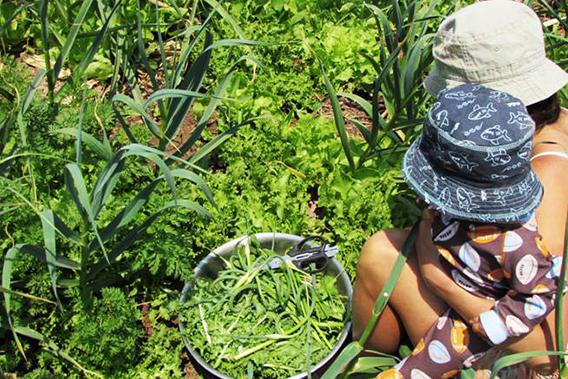A kitchen garden is as much an act of self-expression as a means of growing food. But not all of a garden’s expressiveness is intentional. In the same way that pets and their owners can grow to resemble one another, gardens can reflect their gardeners’ personality, especially how fastidious, lazy, or greedy they are.
It would be a stretch to accuse me of being overly tidy, and the same can be said for my garden. But lazy and greedy? Guilty as charged. And when I allow these tendencies to play out in the garden, the target result is high output with minimal input, to indulge both my great expectations and my, shall we say, hands-off approach.
At the core of my low-effort, high-return gardening style is a practice I call throwing seeds at the garden. This technique is exactly what it sounds like: After preparing the soil and deciding what I’m going to plant in a given plot, I blanket the area with seeds cast by the handful. These aren’t seeds for the plot’s designated crops, but seeds for a supplementary blanket of leafy plants to cover the space between the crop plants.
The seeds, usually a mixture of greens and carrots, grow into an edible, living mulch. I look at it as a bonus crop, as it grows in space that isn’t normally planted. And, like nonedible mulch—e.g., straw, leaves, or grass clippings—my green carpet carries out an important function in the garden as a ground cover.
I often toss seeds at the garden multiple times in a season. This year’s first tossing, just the other week, was a mix of seeds for curly and flat-leafed endive, tall and round radicchio, escarole, lettuce, cilantro, spinach, chard, basil, and whatever else I could scrounge together in the old seed bag. I even threw in sunflowers, nasturtiums, and beets. I simply dumped all my old seeds from last year’s garden in a bag, walked outside, and tossed my seeds at the empty brown garden by the handful, like I was seeding grass.
The garden had been put to bed last winter with early season seed tossing in mind, so it was ready. I raked the ground before and after seeding, and then watered in the seeds really well. Already the edible mulch has begun to grow, making the ground look like it’s dusted with green confetti.
The fact that my garden is basically one big garlic patch works well for my practice, because garlic is a great crop to throw seeds at. Garlic plants grow vertically, both above and below ground, so there is no conflict with other leaves or roots. Garlic doesn’t need much tending in general, so you won’t be stepping much on your greens and carrots. Also, garlic likes mulch, and if I wasn’t using this edible living mulch I’d have to mulch it with something else, like straw. After the garlic is harvested in July, it’s off to the races for the scattered carrots and greens, which suddenly have the place to themselves.
Other crops that work well intercropped with edible mulch are similarly lanky, nonspreading plants like corn, onions, broccoli, cauliflower, and Brussels sprouts, to name a few. Tomatoes, strawberries, and other slow-spreading plants can work as well. After all, tomatoes don’t really fill in until July. You can grow a lot of greenery in the space between in the meantime. You can also train tomatoes vertically to allow more salad space between plants.
Even if you don’t know what main crop you want to plant yet, you can start your garden as soon as the ground has thawed enough to be worked, by throwing seed mix at your blank garden now, and planting into it when the occasion arises. Say you’re at the farmers market and see some beautiful eggplant or pepper transplants to buy. You just take them home, clear a space in the salad and carrot patch, and pop them in. While the transplants are still small you may have to “weed” the neighboring mulch plants to make sure the new starts don’t get smothered by salad.
It’s well-known that eating green leafy vegetables offers multiple health benefits. In addition to the dietary advantages of edible green mulch, it’s also a basic part of my zero-tolerance policy toward exposed earth. Any piece of ground that I can glimpse between plants is a place where sunlight is being wasted. Every squandered photon is a missed opportunity for edible plant growth, and can actually hinder progress if it strikes bare earth. Sun and wind both allow moisture to escape the ground. Sun can heat the ground and bake it, while wind can blow topsoil away.
My edible mulch discourages such damage by forming a thick green mat that captures the sunlight and shields the ground from the elements. It holds the soil in place, tempers the daily extremes of hot and cold, and fosters an active bacterial presence in the soil, which can make a big difference in the garden’s yield.
And, anytime you want to have a salad or a stir fry, tear into that green mulch. It will eagerly grow back, which means that unless you’re a total salad addict you can harvest as much as you like. When the garden has finally run its course come fall, make sure to dig up the carrots before the tops die in the frost. After that, the carrots will still remain happy and delicious in the ground—if you can find them. Without the tops to flag them, you won’t know where to dig.
This is a Web-only exclusive of Flash in the Pan, a nationally syndicated weekly food column by Ari LeVaux.
